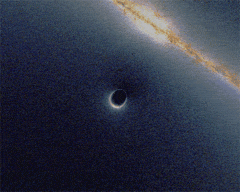
Meanwhile, Sun Hong Rhie (University of Notre Dame) was working on a completely different problem. One of the most visually stunning results of Einstein's General Theory of Relativity is the phenomenon known as gravitational lensing. General Relativity tells us that the fabric of space and time are warped in the presence of mass. As a consequence, a large mass in space can deflect light. For very large masses, this warping effect creates a sort of lens for light emitting objects behind the mass. The following shows a simulation of what we might see if a black hole passed in front of a galaxy.
 Rhie had specifically worked on how many separate images of a background star would be produced by a lens composed of n stars. In the Hubble Space Telescope image at left, the white objects are the multiple lensed images of the background galaxy, more than 11 billion light-years away. The orange objects are images of the three galaxies some 7 billion light-years away whose gravity is "bending" the light from the background galaxy to produce the multiple images. She conjectured that the maximum number of multiple images would be 5n - 5, even providing an example. In reaching this conclusion, she had actually used the rational harmonic function that Khavinson and Neumann had been working on. But more importantly, she showed that the 5n -5 case existed!
Rhie had specifically worked on how many separate images of a background star would be produced by a lens composed of n stars. In the Hubble Space Telescope image at left, the white objects are the multiple lensed images of the background galaxy, more than 11 billion light-years away. The orange objects are images of the three galaxies some 7 billion light-years away whose gravity is "bending" the light from the background galaxy to produce the multiple images. She conjectured that the maximum number of multiple images would be 5n - 5, even providing an example. In reaching this conclusion, she had actually used the rational harmonic function that Khavinson and Neumann had been working on. But more importantly, she showed that the 5n -5 case existed!So, whereas Khavinson and Neumann knew that no solutions existed greater than 5n -5, they didn't know that this was the maximum limit. It could have been lower. And, whereas Rhie knew that she could construct the 5n - 5 case, she didn't know if this was the maximum limit. Therefore, when you marry these two solutions together, you get something quite neat: a proof that the solution to the rational harmonic function composed of relatively prime polynomials with maximum degree n is maximally bounded at 5n - 5. How exciting is that? For Rhie, this means that 5 intervening stars will produce no more than 20 images of a background star. For Khavinson and Neumann, it meant a nice mathematical paper proving their conjecture (pdf warn).
New Scientist has more on this.
(edited 6/9/08 to correct statement regarding degree of resultant polynomial. Thanks go to sphenisc on the JREF forums for pointing it out.)
No comments:
Post a Comment